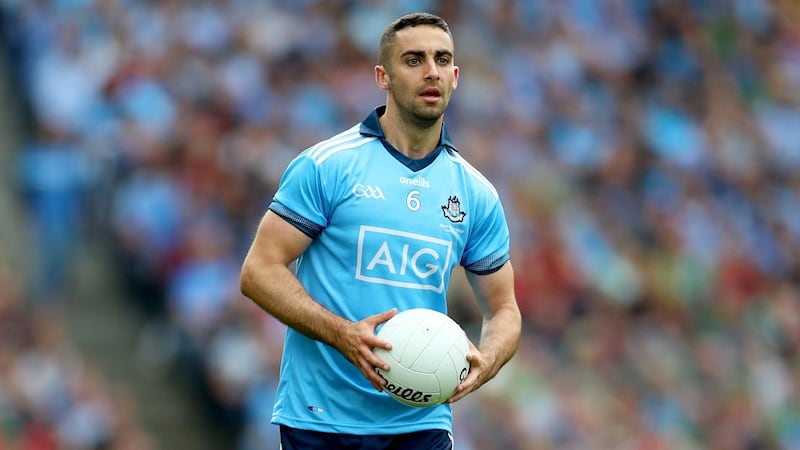Ten minutes into the 2014 All-Ireland semi-final, James McCarthy delivered a cushioned kick-pass over the top of the Donegal defence which sat up perfectly for its recipient, Eoghan O’Gara.
The execution was both nonchalant and precise, delivered as McCarthy moved forward with the ball in that galloping, easy style of his, and kicked with a slight emphasis on the outside of his right foot. It was inch-perfect. The move should have yielded a goal for Dublin and in the maelstrom which followed that demonstration of skill was forgotten. But it was a gorgeous pass and it was an eye-catching example of the subtle depth to McCarthy’s game.
“The other player who could do that without breaking stride was Michael Donnellan,” says Dr Niall Moyna. “I remember seeing Michael at the tail-end of his career in Chicago solo up the field and deliver the ball without breaking stride. James has that. There is no slow down or turn the corner. He’s moving and he places the ball on the side of his foot. It’s never flashy with James. It is with purpose.”
Moyna coached McCarthy at DCU. He recalls a figure who was kind of a contradiction: laid-back and exceptionally pleasant off the field, quiet in the dressing room but just a vivid force of nature once the game started. “He was a wrecking machine. He was half the size he is now but he loved that physical contact.”
But it was McCarthy’s innate reading of the game and understanding of his role within that game that always impressed Moyna most. He has watched, with some pleasure, as his former pupil has matured into what he has become for Dublin.
But what McCarthy has become is seldom spoken about. He is, quite simply, the man at the furnace of this era of Dublin splendour. Along with Stephen Cluxton, Michael Fitzsimons and Michael Darragh Macauley, he was just one of four players to start both the 2011 All-Ireland final win and the drawn game against Kerry a fortnight ago.
Constant presence
Throughout that time, he has been the constant presence as the team has changed radically in both composition and style. McCarthy has moved from his original incarnation as a gangly wing back with a huge, loping stride and a game attitude, into a player who is indispensable to the cause. Has there ever, in all of those years, been a moment of debate as to whether McCarthy makes the team?
The only question about McCarthy around the city on Saturday morning, as the suburbs rev up for another crack at this history thing, is whether they need him more at midfield or at centre back. Declan Sheehan was McCarthy’s first senior coach with Ballymun Kickhams. Sheehan played alongside John, James’s father, and to the Hill crowd of a certain vintage, the original McCarthy: the rapier forward who tormented Kerry during the Heffernan era.
“I knew him from when James was a kid,” Sheehan says. “I lived closed to the family in Glasnevin. He had long curly hair growing up. John came in with me when I started coaching. I remember one day I sat down and had a chat with James and asking about that. A lot of pressure on the young fella when you think about it, with the history of his dad and the two older brothers playing with Kickhams. But he took everything in his stride. Very easy going. Well able to handle whatever was thrown at him.
“I told him once he had massive potential as a midfielder. It doesn’t matter how big the pitch is, he is going box to box. He just chews the ground up. My big ambition was to mould him as a midfielder. Sometimes James could stay in his comfort zone a little bit and he’d say: ‘I’m not really sure’. And I’d keep saying, look you have it. We had one or two defeats at senior level along the way but he was so good. And I really think that James and Brian Fenton is the best midfield pairing in the GAA now.”
When Paddy Christie got a group of players together to send a volt of energy and purpose through Ballymun’s underage structure, it coincided with the arrival of James Glancy, the Leitrim footballer, as coaching officer in the area. Glancy sometimes coached the club’s minor team and noticed two tall and conspicuously talented teenagers always knocking about together. He didn’t know who they were until he asked and found out that they were Barney Rock’s and John McCarthy’s young lads.
Glancy was there to witness their progression through Jim Gavin’s All-Ireland winning under-21 team in 2010 to the Dublin teams that have dominated this decade at All-Ireland senior level.
“As time went by I got to know James a bit better. He never let the kids down and turned up when he said he would. And he never forgot where he came from. I’m not saying other footballers don’t. But to me he was always very good to Sacred Heart school and to and St Kevin’s there. And he always said, if I do one school, I have to do them all.”
When he thinks of McCarthy as a minor, he instantly sees “a long stringy lad”. But in the years after Glancy arrived, the Kickhams got gym equipment into the clubhouse upstairs and burned out plenty of light bulbs over the following winters. They had produced two terrific underage teams. Both McCarthy and Rock were just 17 when they were part of Paddy Christie’s under-21 team that won an important county championship for the club.
They made a concerted effort to chase down the club’s first senior title since 1985. Glancy saw the transformation in McCarthy’s physique – still long and striding but with formidable upper body strength – during those years.
“Ballymun trained like a county team then. They were way ahead in their set-up. And it was self-generated. The players drove it.”

Patience
The one thing that Sheehan noticed about McCarthy as he evolved into a senior county player was his patience. “I do think he had to work hard on his temperament. When things went against James you could see the frustration and he would sometimes do something stupid, not in a bad way but it was something he had to learn. But he has matured and he accepts that things won’t go 100 per cent in a game and he deals with that well now.”
There have been flashpoints: a red card dismissal during a stormy league encounter with Donegal in March of 2016 and an infamous and controversial black card in the 25th minute of the All-Ireland final of the same year. He was called for body-checking Cillian O’Connor in one of those sequences that was highly open to interpretation and he could only watch as the teams played out a draw.
“I left it behind me but if we lost that game the first day it would haunt me for the rest of my life,” a relieved McCarthy told Brian Carthy on RTÉ that October. “It worked out. I was happy how we played in the replay and was just delighted to be able to help my team mates.”
It’s that understated, blue-collar role in which McCarthy glories: the resolutely out-of-the-limelight worker for the cause. But as the years have gone on, it’s clear he is so much more. When Dublin needed a firefighter to put on Tommy Walsh two weeks ago, they went with McCarthy. When Dublin were pushed to the brink against Mayo in 2017 – 1-14 to 1-15 down after 65 minutes and needing something – it was McCarthy, after an hour of box-to-box running who found the energy to get up the field to curl the right-footed point that got them in motion again.
“He reminds of Alberto Juantorena [Cuban 400m athlete] ,” Moyna says. “He covers ground effortlessly. If you watch James when Dublin are dominating, you never see him in the attack. He just hangs back and does his job. But it’s amazing: when the shit hits the fan and they need someone to get up field, pick up a ball and stick it over the bar, James never lets them down.”
In the teak-tough, soaked All-Ireland final of 2015, with Kerry pushing for a goal to level a low-scoring match and the ball spilled late on, it was McCarthy who was perfectly placed to sweep up, collecting a possession that was bouncing dangerously in front of Cluxton’s goal. Everyone remembers Alan Brogan’s famous point that sealed the deal that year, but it was McCarthy who set the move in motion with that clearance.

Timed runs
During the era of compact defences, it was McCarthy’s give-and-go breaks, bursting defences open with perfectly timed runs, that became Dublin’s go-to tools again and again. Bernard Brogan was often the finisher but the original damage was done by McCarthy.
“He has added something new to his game every year,” Glancy says. The Leitrim man still reckons McCarthy’s best position is where he started out. “I think he is just brilliant there. It goes back to his skill-set and his basics. I always try to get kids to play off both hands and both feet. James has that. But Dublin need him at six.”
And at eight! For Sheehan, his former neighbour, he will always be a midfielder first and foremost. Moyna reckons he is one of the very few players at the elite level with the requisite skills to slip seamlessly into full back, wing back or centrefield. All reckon that his peak years might still be ahead of him.
He’s done this very quietly, maybe taking his cue from his father, whose exploits he heard about outside rather than inside the home. “He wouldn’t be telling you,” he said in an interview with the Daily Star. “He wasn’t like that, not a blower.”
This evening, the stringy lad from Ballymun will play for his sixth All-Ireland medal as a starting player. He turns 29 in November. Dublin supporters know that there are probably considerable changes coming this autumn, irrespective of what happens in the final.
Familiar faces will bow out. But in James McCarthy, the consistent, understated exemplar throughout this period, the pillar of the team remains intact. Only when it’s gone will its scale and significance become fully apparent.











